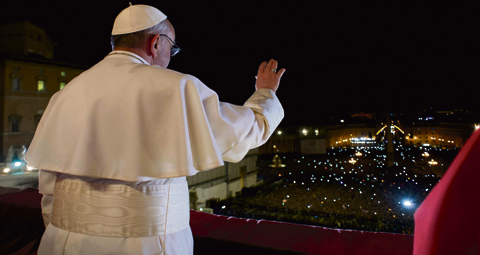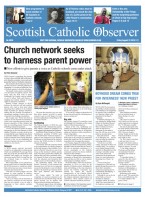BY Ian Dunn | March 22 | ![]() 0 COMMENTS
0 COMMENTS ![]() print
print

Pope Francis will illuminate the Church
IAN DUNN gives an insight into the background of the newly-elected Holy Father and attempts to deduce the characteristics that will mark his Papacy
On December 17, 1936 a boy was born in a suburb of Buenos Aires, Argentina, and last Wednesday that same boy was elected Pope. Jorge Mario Bergoglio may be considered the first truly global Pope, born thousands of miles from the Vatican.
Archbishop Philip Tartaglia of Glasgow, the president of the Bishops’ Conference of Scotland, believes that the new Pope’s choice of name, Francis, is of great significance.
“The name gives us clues as to what type of Pope he will be,” Archbishop Tartaglia said. “… St Francis of Assisi, which is what I thought of immediately, in terms of being a poor servant of Jesus and a carer of the poor. But also Francis of Assisi was given the message: ‘Rebuild my Church,’ and that is a very important idea in the present time.’”
Only after he fully takes on the mantle of Pontiff over time will we learn the kind of Pope, Francis will become. That, however, will no doubt be shaped by the man, priest and cardinal for the poor and poor in spirit he has been throughout the last 76 years of his life.
Early life
He was the son of Mario Bergoglio, a railway worker who had immigrated to Argentina from Italy’s Piedmont region, and his wife Regina María Sivori, a housewife born in Buenos Aires to a family also of Piedmontese origin. He was one of five children but his youth was not idyllic as he suffered from cysts on his lungs and as a teenager he underwent surgery to remove a lung due to serious infection. Thankfully, he made a full recovery and became a keen cyclist who pursued the hobby into his 70s.
Following his high school graduation, he enrolled at Buenos Aires University, where he received a master’s degree in chemistry. He enrolled in a seminary at the age of 21 and began training at the Jesuit seminary of Villa Devoto. In March 1958, he entered the Society of Jesus. He went on to attend the philosophical and theological faculty of San Miguel, where he earned a degree in philosophy, and later received a doctorate in theology in Freiburg, Germany.
Vocation
By all accounts, he was a brilliant student who relished the study not just of theology but also of secular subjects like psychology and literature. He was ordained a priest a few days short of turning 33, and from that point on, his ascent within the Church was rapid: by 1973, he had been named the Jesuit provincial for Argentina, the Church official in charge of supervising the order’s activities in the country.
Ordained as a priest in December 1969, he began serving as Jesuit provincial of Argentina in 1973. He later returned to his alma mater, the philosophical and theological Faculty of San Miguel, where he served as rector (1980-86) as well as a professor of theology.
In June 1992, he was named titular bishop of Auca and auxiliary of Buenos Aires by Pope John Paul II, and in February 1998, he became archbishop of Buenos Aires, succeeding Archbishop Antonio Quarracino. Three years later, in February 2001, he was elevated to cardinal. In 2005, he was named president of the Bishops’ Conference of Argentina, serving in that position until 2011.
During his time as the head of the Argentine Church he became popular for the simplicity of his lifestyle. He often rode the bus to work, cooked his own meals and regularly visited the slums that ring Argentina’s capital. He also urged Argentines not to travel to Rome for his installation as cardinal and instead give the money they would have spent on plane tickets to the poor, something he reiterated after his election as Pope last week. Once a cardinal, he also made a point of reminding his fellow clergy that the Church belonged with the Poor and Jesus Christ bathed lepers and ate with prostitutes.
“Jesus teaches us another way: Go out,” he told Argentina’s priests last year. “Go out and share your testimony, go out and interact with your brothers, go out and share, go out and ask. Become the Word in body as well as spirit.”
His legacy as cardinal includes his efforts to repair the reputation of a Church that lost many followers by being too closely associated with the brutal dictatorship that ruled from 1976-83. Under his leadership, Argentina’s bishops issued a collective apology in October 2012 for the Church’s failures to protect its flock. Though the statement blamed the era’s violence in roughly equal measure on both the junta and its enemies.
Influence
Cardinal Bergoglio also worked to recover the Church’s traditional political influence in Argentine society, but his strong criticism of President Cristina Fernández de Kirchner could not stop her from imposing same-sex ‘marriage’ and free contraceptives on the Latin American nation.
He vigorously opposed legislation introduced in 2010 to legalise same-sex ‘marriage’ in Argentina, calling it a ‘real and dire anthropological throwback.’ In July 2010, while the law was under consideration, he wrote a letter to Argentina’s cloistered nuns in which he said it was a hugely dangerous step.
“In the coming weeks, the Argentine people will face a situation whose outcome can seriously harm the family,” he wrote. “At stake is the identity and survival of the family: father, mother and children. At stake are the lives of many children who will be discriminated against in advance, and deprived of their human development given by a father and a mother and willed by God. At stake is the total rejection of God’s law engraved in our hearts. Let’s not be naive: This is not a simple political fight; it is a destructive proposal to God’s plan. This is not a mere legislative proposal, but a move by the father of lies that seeks to confuse and deceive the children of God. Let’s look to St Joseph, Mary, and the Child to ask fervently that they defend the Argentine family in this moment… May they support, defend, and accompany us in this war of God.”
Mgr Osvaldo Musto, who was at seminary with Cardinal Bergoglio, said this approach was typical unbending loyalty to the teachings of the Church.
“He is as uncompromising as Pope John Paul II, in terms of the principles of the Church,” he said. “Everything it has defended regarding euthanasia, the death penalty, abortion, the right to life, human rights, celibacy of priests.”
Pastoral work
Cardinal Bergoglio has been equally uncompromising in his dedication to the plight of South America’s poor. As Cardinal Bergoglio, his sermons always had an impact in Argentina and he often stressed social inclusion, indirectly criticising governments that did not pay attention to those on the margins of society.
“We live in the most unequal part of the world, which has grown the most yet reduced misery the least,” he said at a gathering of Latin American bishops in 2007. “The unjust distribution of goods persists, creating a situation of social sin that cries out to Heaven and limits the possibilities of a fuller life for so many of our brothers.”
This concern is part of his remarkable personal compassion, shown in 2001 when he visited a hospital to wash the feet of patients who had AIDS. He has also called for more pastoral care of divorced Catholics, and he memorably castigated Argentine priests who refused Baptism to the child of an unwed mother as ‘today’s hypocrites.’
“In our ecclesiastical region there are priests who don’t Baptise the children of single mothers because they weren’t conceived in the sanctity of marriage,” he said. “These are today’s hypocrites. Those who clericalise the Church. Those who separate the people of God from salvation. And this poor girl who, rather than returning the child to sender, had the courage to carry it into the world, must wander from parish to parish so that it is Baptised!”
He compared this concept of Catholicism, ‘this Church of ‘come inside so we make decisions and announcements between ourselves and those who don’t come in, don’t belong,’’ to the Pharisees of Christ’s time—people who congratulate themselves while condemning all others.
This sort of pastoral work, aimed at capturing more souls and building the flock, was an essential skill for any religious leader in the modern era, said his authorised biographer, Sergio Rubin.
“It is a very curious thing: When bishops meet, he always wants to sit in the back rows,” Mr Rubin said. “This sense of humility is very well seen in Rome.”
Election as Pope
It seems this humility was very well regarded among his fellow cardinals as it has been widely reported that after Pope John Paul II’s death in April 2005, he reportedly received the second-most votes in the 2005 Papal election.
On March 13, 2013, at the age of 76, Jorge Bergoglio was named the 266th Pope of the Roman Catholic Church—becoming the first citizen from the Americas, the first non-European and first Jesuit priest to be elected Pope, and adopting the name Pope Francis, after St Francis of Assisi of Italy, a Catholic preacher during the 12th and 13th centuries.
Back in Argentina, the land of his birth, his sister María Elena Bergoglio, 12 years his junior, said she was ‘totally proud’ but feared her brother now faced a job of ‘infinite loneliness.’
“I didn’t want him to become Pope because he’s going to be very far away, and second, because it is such a large responsibility,” she said. “But I am also totally proud that he is the new Pope—because he’s the first from outside Europe, because he’s Latin American, he’s Argentine and he’s my brother.”
From what she had seen of his own reaction to the news on television, he also seemed pleased, she said. “The expression on his face spoke of a fullness of heart,” she added.
Let us hope that ‘fullness of Heart’ spreads to and remains with the whole of the Church.










